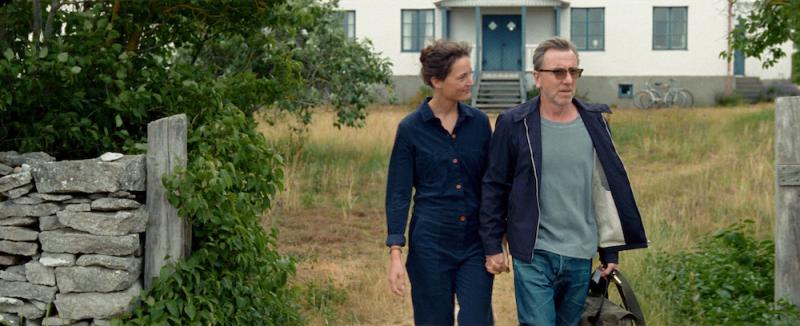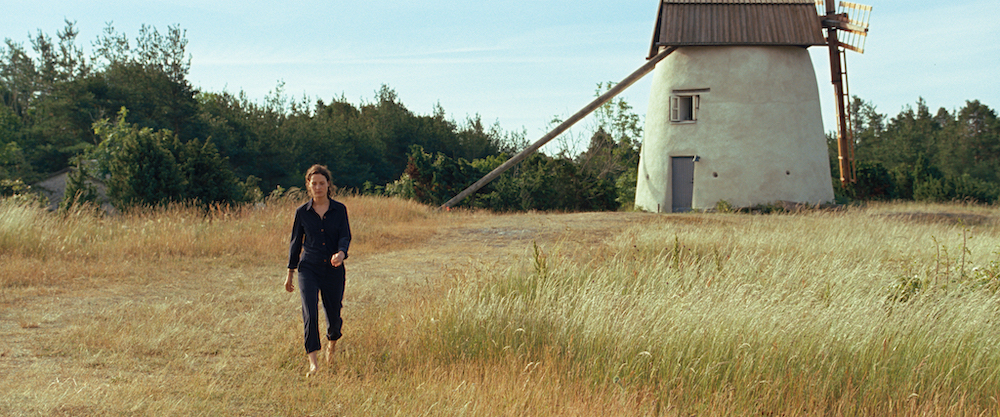Bergman Island review - Mia Hansen-Løve's joyful English-language debut | reviews, news & interviews
Bergman Island review - Mia Hansen-Løve's joyful English-language debut
Bergman Island review - Mia Hansen-Løve's joyful English-language debut
Never too meta: an intriguingly open-ended story incorporates a film within a film

French director Mia Hansen-Løve’s graceful, intriguingly open-ended seventh feature, and her English-language debut, is set on Fårö, the island that Ingmar Berman loved.
“This is your landscape, Bergman. It corresponds to your innermost imaginings of form, proportions, colours, horizons, sounds, silences, lights and reflections,” he wrote. He lived on the island for 40 years and made several films there, including Through a Glass Darkly, Persona and the TV series that inspired millions of divorces, Scenes from A Marriage.
In Bergman Island, the Swedish director is an inspirational presence, though not in an overt, reverential way – in fact one character slags him off mercilessly. Nordic seriousness is absent: this is, in many ways, a light-hearted movie, with the unusual mix of Lee Hazlewood, ABBA, and finally Tina Charles as an irresistible wedding-dance sound-track. And Denis Lenoir’s beautiful cinematography shows off those colours and horizons of Fårö, with its endless sea and sky and small settlements of houses.
But still, film-makers Chris (the wonderful Vicky Krieps; Phantom Thread) and Tony (Tim Roth) have Bergman in mind as they work on their screenplays in the idyllic – perhaps too idyllic, Chris thinks – artists’ retreat set up by the Bergman Foundation. Their relationship – they have a young daughter, who’s with her grandmother while they’re away – seems to be at some sort of crossroads, never spelled out.
 They’re staying in the bedroom used in Scenes from a Marriage, as the caretaker points out gleefully, and the elusive Chris teases Tony about sleeping in separate rooms to escape its curse. As it is, she lays claim to the mill next to the house to work in, separating herself from Tony, his copy of Strindberg’s Inferno and his notebook with its erotic drawings that she peruses dubiously while he’s out.
They’re staying in the bedroom used in Scenes from a Marriage, as the caretaker points out gleefully, and the elusive Chris teases Tony about sleeping in separate rooms to escape its curse. As it is, she lays claim to the mill next to the house to work in, separating herself from Tony, his copy of Strindberg’s Inferno and his notebook with its erotic drawings that she peruses dubiously while he’s out.
Her work seems to be at an impasse. “How can I not feel like a loser?” she complains, with Bergman’s huge body of work lurking in the background. “No one is expecting Persona,” says Tony, who’s a famous director, appearing on several panels and admired by many of the intense Bergman buffs in evidence at the retreat.
When she complains that he never tells her anything about his work, he reveals that his script is about “invisible things circulating within a couple” – which sums up, perhaps, what Hansen-Løve's film is about. They watch Cries and Whispers in Bergman’s screening room, where a chair in the front row must be kept empty: it’s Bergman’s. Solitude, agony, fear of dying: "I hope he had more fun in his life," says Chris.
And, with some foundation members, they discuss Bergman’s cruelty in life as in work. He had nine children with six different women. The mothers did everything, he did nothing, muses Chris. “I’d like to have nine kids with six different men,” she smiles. “Nice,” sighs Tony, in a long-suffering way.
When Tony gets on the bus for the Bergman Safari – an actual Fårö tourist attraction – Chris slopes off with a Stockholm film student who promises to show her places that aren’t on the safari. You expect something momentous to happen, perhaps the beginning of an affair, but no, they visit sand dunes, then swim, hurling jellyfish at each other. Chris’s fearless joie de vivre is palpable. Tony’s briefly miffed that she stood him up for the safari, but they laugh it off affectionately. There are no easy answers or clichés here.
 What Chris wants from him is advice about her project, and the second half of Bergman Island goes meta, though not in an annoyingly self-conscious way, with Chris’s screenplay, The White Dress. Suddenly we’re in new territory, or not so new at all: her film within a film is set on Fårö, starring Mia Wasikowska (pictured above) as Amy, a film-maker who’s come to the island for the wedding of a friend and also to reconnect, after many years, with her first love, Joseph (Anders Danielsen Lie). They met as teenagers; now she has a four-year-old daughter, like Tony and Chris. He has several girlfriends, she has someone else (though only one other) but there’s still an overwhelming attraction. At first, their reunion is passionate, but then Joseph goes cold on her, and it’s clear that the dynamic is uneven. She’s heart-broken again (shades of Hansen-Løve's Goodbye, First Love).
What Chris wants from him is advice about her project, and the second half of Bergman Island goes meta, though not in an annoyingly self-conscious way, with Chris’s screenplay, The White Dress. Suddenly we’re in new territory, or not so new at all: her film within a film is set on Fårö, starring Mia Wasikowska (pictured above) as Amy, a film-maker who’s come to the island for the wedding of a friend and also to reconnect, after many years, with her first love, Joseph (Anders Danielsen Lie). They met as teenagers; now she has a four-year-old daughter, like Tony and Chris. He has several girlfriends, she has someone else (though only one other) but there’s still an overwhelming attraction. At first, their reunion is passionate, but then Joseph goes cold on her, and it’s clear that the dynamic is uneven. She’s heart-broken again (shades of Hansen-Løve's Goodbye, First Love).
How this simple, compelling story relates to Chris and Tony’s relationship isn’t obvious, but what is important is the subtle way Hansen-Løve explores the nature of creativity, showing how Chris finds strength in the mirror between life and art, and how she solves her impasse without help from Tony. I love to love/but my baby just loves to dance is as good a closing comment as any to this surprisingly joyful film.
rating
Explore topics
Share this article
The future of Arts Journalism
You can stop theartsdesk.com closing!
We urgently need financing to survive. Our fundraising drive has thus far raised £49,000 but we need to reach £100,000 or we will be forced to close. Please contribute here: https://gofund.me/c3f6033d
And if you can forward this information to anyone who might assist, we’d be grateful.

Subscribe to theartsdesk.com
Thank you for continuing to read our work on theartsdesk.com. For unlimited access to every article in its entirety, including our archive of more than 15,000 pieces, we're asking for £5 per month or £40 per year. We feel it's a very good deal, and hope you do too.
To take a subscription now simply click here.
And if you're looking for that extra gift for a friend or family member, why not treat them to a theartsdesk.com gift subscription?
more Film
 London Film Festival 2025 - crime, punishment, pop stars and shrinks
Daniel Craig investigates, Jodie Foster speaks French and Colin Farrell has a gambling habit
London Film Festival 2025 - crime, punishment, pop stars and shrinks
Daniel Craig investigates, Jodie Foster speaks French and Colin Farrell has a gambling habit
 I Swear review - taking stock of Tourette's
A sharp and moving tale of cuss-words and tics
I Swear review - taking stock of Tourette's
A sharp and moving tale of cuss-words and tics
 A House of Dynamite review - the final countdown
Kathryn Bigelow's cautionary tale sets the nuclear clock ticking again
A House of Dynamite review - the final countdown
Kathryn Bigelow's cautionary tale sets the nuclear clock ticking again
 theartsdesk Q&A: Idris Elba on playing a US President faced with a missile crisis in 'A House of Dynamite'
The star talks about Presidential decision-making when millions of lives are imperilled
theartsdesk Q&A: Idris Elba on playing a US President faced with a missile crisis in 'A House of Dynamite'
The star talks about Presidential decision-making when millions of lives are imperilled
 Urchin review - superb homeless drama
Frank Dillane gives a star-making turn in Harris Dickinson’s impressive directorial debut
Urchin review - superb homeless drama
Frank Dillane gives a star-making turn in Harris Dickinson’s impressive directorial debut
 Mr Blake at Your Service review - John Malkovich in unlikely role as an English butler
Weird comedy directed by novelist Gilles Legardinier
Mr Blake at Your Service review - John Malkovich in unlikely role as an English butler
Weird comedy directed by novelist Gilles Legardinier
 Don't Let's Go to the Dogs Tonight review - vivid adaptation of a memoir about a Rhodesian childhood
Embeth Davidtz delivers an impressive directing debut and an exceptional child star
Don't Let's Go to the Dogs Tonight review - vivid adaptation of a memoir about a Rhodesian childhood
Embeth Davidtz delivers an impressive directing debut and an exceptional child star
 One Battle After Another review - Paul Thomas Anderson satirises America's culture wars
Leonardo DiCaprio, Teyana Taylor, and Sean Penn star in a rollercoasting political thriller
One Battle After Another review - Paul Thomas Anderson satirises America's culture wars
Leonardo DiCaprio, Teyana Taylor, and Sean Penn star in a rollercoasting political thriller
 Steve review - educator in crisis
Cillian Murphy excels as a troubled headmaster working with delinquent boys
Steve review - educator in crisis
Cillian Murphy excels as a troubled headmaster working with delinquent boys
 Can I get a Witness? review - time to die before you get old
Ann Marie Fleming directs Sandra Oh in dystopian fantasy that fails to ignite
Can I get a Witness? review - time to die before you get old
Ann Marie Fleming directs Sandra Oh in dystopian fantasy that fails to ignite
 Happyend review - the kids are never alright
In this futuristic blackboard jungle everything is a bit too manicured
Happyend review - the kids are never alright
In this futuristic blackboard jungle everything is a bit too manicured

Add comment